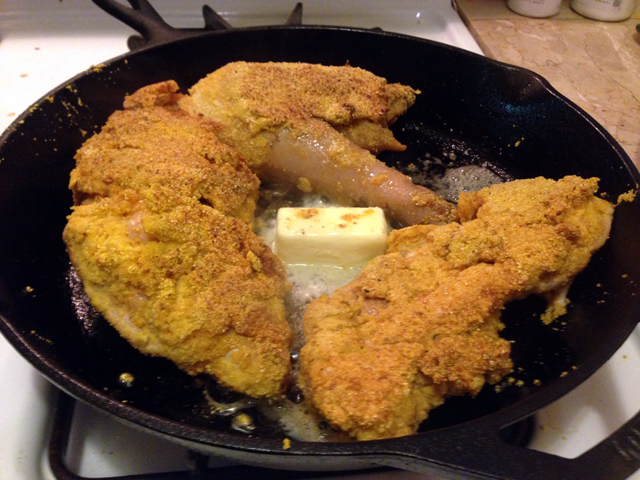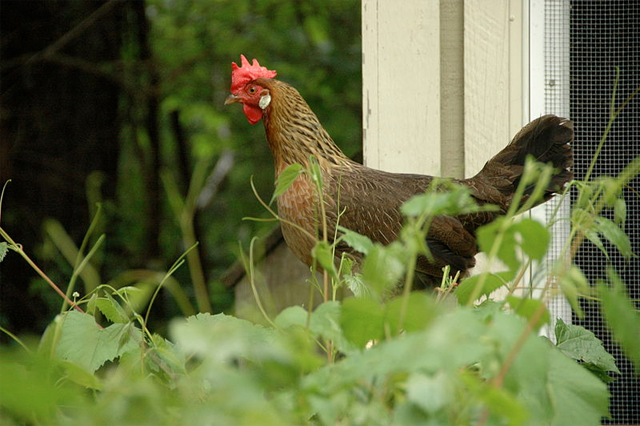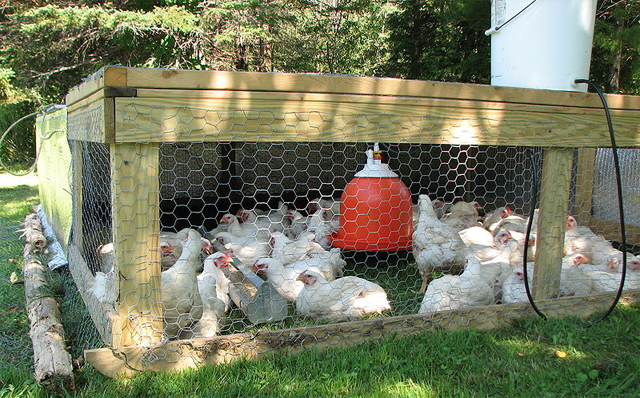Looking For Leghorn: Why Aren't Heritage Chickens On The Table?
By Melissa McEwen in Food on May 23, 2014 3:45PM
Hip new “socially conscious” fried chicken restaurant Leghorn is named after a breed of chicken, but you won’t find any Leghorns in the restaurant. I went looking to eat this iconic breed, and I learned more than I expected about the Leghorn, and other heritage breeds that are no longer on our tables.
Leghorn business partner Jared Van Camp told us that he chose the name Leghorn because it references a heritage breed that was almost lost to industrial agriculture’s homogeneity. It’s a breed that once roamed the barnyards of almost every American small farm until the pressure to produce more food industrially led to its being selectively bred and hybridized into a bird that looks like a lethargic shadow of its ancestors.
That left us two forms of the Leghorns: an industrial bird that rules the roost in egg farms across the country, and the heritage breed that looks like its ancestors. But you won’t find either version of the breed on the restaurant’s menu. Van Camp told us it wouldn’t fit in there because it’s a laying breed that at best could suit a stewing dish like coq au vin, not fried chicken. So I thought I’d track down some heritage Leghorn chicken farmers to see what could be done to bring these birds to the table again.
Like most restaurants in Chicago that tout premium poultry, Leghorn sells a modern breed of poultry, known in the industry as a hybrid. They are mostly raised indoors as part of larger-scale vertically integrated operations. Premium operations like Miller Amish Poultry don’t use antibiotics and they adhere to Step Two of Whole Foods' animal welfare standards, which prohibits common industrial practices like debeaking. But otherwise they resemble larger conventional farms in their animal husbandry. And that means these chickens don’t very much resemble the joyous flock on an idyllic barnyard shown on Leghorn’s website.
Even the “free-range” birds come from that same stock. Free-range farmers buy their chickens from a hatchery each year and slaughter them when they reach seven weeks to five months old. They have to, because hybridized hatchery chickens bred for high meat production have a built-in expiration date. They grow rapidly and sport breasts twice as large as most heritage lines, which comes at a price: their hearts are smaller and many suffer from skeletal abnormalities. With little ability to run from hazards like predators, it’s no wonder Miller says they keep their birds inside for their own protection and many free-range farmers report they won’t go outside even if offered access.
The ASPCA has recently started a campaign against these types of fast-growing hybridized chickens. Ben Goldsmith, the executive director of animal welfare organization Farm Forward says “no matter how ‘humane’ a set of farm practices is, as long as practices include contemporary hybrid poultry breeds, the standard of welfare is going to be quite low.”
I managed to track down a farmer who actually does raise and sell heritage Leghorn chickens. Frank Reese of Good Shepherd Poultry in Kansas City raises a variety of heritage chickens on pasture, where they forage for bugs and wild plants. He says true heritage birds must be of a breed that existed before 1950, must not be hybridized and they must breed naturally. Some chickens touted as heritage, such as those found in hatchery catalogs, don’t fit those standards.
Reese claims that a heritage bird is a happier healthier bird and that it may even be better for you. He has worked with meat science specialist Dr. Liz Boyle at Kansas State University to study the nutritional differences between his chickens and hybrid conventional chickens. The final paper has not been published yet, but graduate student Alexandra R. Christiansen’s thesis presents preliminary data which shows the heritage meat has more protein than fat compared to conventional chickens. It also indicated that the fat had a more favorable ratio of Omega-6 fats to Omega-3, which has been associated with reduced risk of heart disease.
But they are hard to find at a store. Heritage Foods USA is one of the few places that distributes true heritage chickens. Order director Catherine Greeley says they’ve been piloting Good Shepherd’s chickens in a few New York City restaurants. An obstacle is that chefs prefer to work with a fresh rather than frozen product, and small farmers who raise their chickens outdoors and don’t have their own slaughterhouses can’t keep up a constant level of production year-round. This is especially an issue when restaurants serve mainly one type of meat like fried chicken. Greeley says they are working with chefs to come up with a distribution market that works for the farmer and the chef and will expand to other cities once they work out the kinks.
Chef Steve Pope is a consultant who travels all over the United States and specializes in helping restaurants put heritage birds on their menus. He says another obstacle is education – each heritage bird is very different, and chefs these days aren’t familiar with the differences or how to choose and cook each type. “The whole process has to be re-learned to work with heritage birds,” he said. “It takes training.”
It’s a challenge, but it has its rewards. Pope says the flavor and texture of a properly cooked heritage bird is incomparable to its conventional counterpart. I decided to put it to the test and ordered two frozen Leghorns from Heritage Foods. They weren’t cheap, so I knew I had to do them right. I talked with Big Jones’ Paul Fehribach about the history of fried chicken. He says its roots lie in the country cooking of peoples whose roots were in Scotland and Africa. “When I was growing up, this was a special occasion food,” Fehribach said.
Making these chickens helped me understand why. I researched traditional methods of chicken preparation in Africa and Europe, as well as older American fried chicken recipes. One particular method caught my eye – an older American method known as Chicken A La Maryland, involving pan-frying in a cast iron with butter. It had the steaming element of the West African recipes and the breading of the American approach. I chose some popcorn flour for the breading.

Chicken A La Maryland cooked in cast iron skillet
Many old chicken breeds were dual-purpose – for both eggs and meat. They didn’t go into the frying pan until they’d stopped laying eggs. And the ingredients for frying chicken like lard or palm oil weren’t exactly as cheap as the vegetable oil used by most restaurants now. Interestingly, Colonel Sanders of Kentucky Fried Chicken fame always felt deep frying produced sub-par chicken. His family fried chicken slowly in a cast iron skillet with an old flat iron on the lid to create pressure, which is the method I used. When he discovered the professional pressure cooker, he was able to speed up that method and scale it around the world. Though KFC doesn’t exactly serve heritage poultry these days, Frank Reese says the pressure cooker remains an excellent way chefs can quickly cook heritage birds.
The chicken was crispy and delicious and as promised had a special flavor that was extraordinarily rich and savory. It was a far cry from the Chick-Fil-A and Perdue chicken I grew up with in the modern South. I shared my second Leghorn with Chef Justin Behlke of Cellar Door Provisions, who roasted it simply; he said it reminded him almost of a wild game bird. Modern chicken in contrast is so tasteless that people sometimes don’t even notice it’s not there. Chef Pope says that while Leghorn might make a very good fried chicken, he counsels chefs that other heritage breeds such as the Chantecler work even better.
So it tastes delicious, might be healthier and many would agree these birds have a better life than conventional birds. Chefs need to not just like the stories about them, they need to work with farmers to preserve these breeds and put them back on the American table. But it’s going to be hard when chefs have forgotten (or never learned) how to cook them, very few farmers raise them, and consumers – who have largely never tasted this kind of chicken – balk at the prices.
Plus people expect chicken to be cheap, and fried chicken has turned from a seasonal Sunday dinner food to an everyday fast food staple. But the prices are partially much higher than they need to be because of poor infrastructure on the processing and distribution side. Local farmer Greg Gunthorp says the reality is that non-mainstream chicken farming is 15 years behind other meats such as beef or pork. Tom Arnold, who raises free-range chicken in Jo Daviess County, says he currently doesn’t work with Chicago chefs and that he wishes more restaurants would start a dialog with farmers. “They assume we can’t produce, we assume they won’t pay the price.”
Van Camp’s story of a breed that was “almost lost” becomes one of a breed that at this point is still effectively lost. Frank Reese is working to change that, partnering with Farm Forward to build a Good Shepherd Poultry Center. Ben Goldsmith said the center would serve the “urgent need for institutions to address lack of biodiversity and give farmers husbandry skills and create infrastructure for an alternative to the mainstream poultry industry.”
“We need to re-teach people how to do this again,” Reese said. “It’s the only way to make it work.”
Heritage pork can already be found at many restaurants. If Reese gets his way, heritage chicken might soon be on as many menus. Van Camp says he's looking into working with other farmers, maybe someday they'll have a special on their board that is made with heritage chicken.

